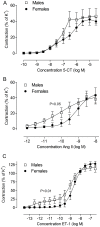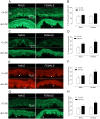Male-female differences in upregulation of vasoconstrictor responses in human cerebral arteries
- PMID: 23658641
- PMCID: PMC3639206
- DOI: 10.1371/journal.pone.0062698
Male-female differences in upregulation of vasoconstrictor responses in human cerebral arteries
Abstract
Background and purpose: Male-female differences may significantly impact stroke prevention and treatment in men and women, however underlying mechanisms for sexual dimorphism in stroke are not understood. We previously found in males that cerebral ischemia upregulates contractile receptors in cerebral arteries, which is associated with lower blood flow. The present study investigates if cerebral arteries from men and women differ in cerebrovascular receptor upregulation.
Experimental approach: Freshly obtained human cerebral arteries were placed in organ culture, an established model for studying receptor upregulation. 5-hydroxtryptamine type 1B (5-HT1B), angiotensin II type 1 (AT1) and endothelin-1 type A and B (ETA and ETB) receptors were evaluated using wire myograph for contractile responses, real-time PCR for mRNA and immunohistochemistry for receptor expression.
Key results: Vascular sensitivity to angiotensin II and endothelin-1 was markedly lower in cultured cerebral arteries from women as compared to men. ETB receptor-mediated contraction occurred in male but not female arteries. Interestingly, there were similar upregulation in mRNA and expression of 5-HT1B, AT1, and ETB receptors and in local expression of Ang II after organ culture.
Conclusions and implications: In spite of receptor upregulation after organ culture in both sexes, cerebral arteries from women were significantly less responsive to vasoconstrictors angiotensin II and endothelin-1 as compared to arteries from men. This suggests receptor coupling and/or signal transduction mechanisms involved in cerebrovascular contractility may be suppressed in females. This is the first study to demonstrate sex differences in the vascular function of human brain arteries.
Conflict of interest statement
Figures




References
-
- Appelros P, Stegmayr B, Terent A (2009) Sex differences in stroke epidemiology: a systematic review. Stroke 40: 1082–1090. - PubMed
-
- Forster A, Gass A, Kern R, Wolf ME, Ottomeyer C, et al. (2009) Gender differences in acute ischemic stroke: etiology, stroke patterns and response to thrombolysis. Stroke 40: 2428–2432. - PubMed
-
- Kent DM, Price LL, Ringleb P, Hill MD, Selker HP (2005) Sex-based differences in response to recombinant tissue plasminogen activator in acute ischemic stroke: a pooled analysis of randomized clinical trials. Stroke 36: 62–65. - PubMed
-
- Zuern CS, Lindemann S, Gawaz M (2009) Platelet function and response to aspirin: gender-specific features and implications for female thrombotic risk and management. Semin Thromb Hemost 35: 295–306. - PubMed
Publication types
MeSH terms
Substances
LinkOut - more resources
Full Text Sources
Other Literature Sources
Research Materials
Miscellaneous

